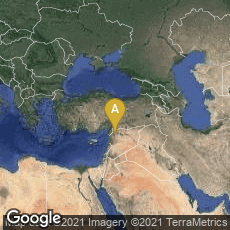"The earliest reference in the Mediterranean world to the Indian system of numeration [Arabic numerals] dated from the mid-seventh century, just after the rise of Islam. In a fragment, dated 662, of a work by Severus Sebokht, the learned bishop of the monastery of Quinnasrin (located on the Euphrates in Syria [25 km southwest of Aleppo]), the bishop expresses his admiration for the Indians because of their valuable method of computation 'done by means of nine signs.' Severus had probably learned about the system from Eastern merchants active in Syria. This ingenious and eminently simple system of representing any quantity by using nine symbols in decimal place value (there was orignally no zero) arose in India perhaps as early as the fifth century. The indian system seems to have been known in Baghdad as early as 770, or less than a decade after its founding, but it was principally diffused through the writings of the Abbasid mathematician and geographer Muhmmad ibn Musa al-Khwarizmi (al-Khwarazmi) who died around 846" (Bloom, Paper Before Print. The History and Impact of Paper on the Islamic World [2001] 129).
From page 48 of A History of Mathematical Notations, by Florian Cajori (1993) we learn that the specific fragment recording this detail is Bibliothèque nationale de France (MS Syriac [Paris], No. 346).
Roger-Pearse.com provides these details regarding Ms. Paris Syriaque 346:
"Ms. Paris Syriaque 346
This manuscript contains a large quantity of works by Severus Sebokht, and is the main source for his works.
[4]The Syriac manuscripts 1-288 are described by Herman Zotenberg in his Catalogue des manuscrits syriaques et sabéens (mandaïtes) de la bibliothèque nationale, Paris (1874), which was completed for mss. 289-334 by J-B. Chabot. The following manuscripts are described in a handwritten supplement to Chabot's catalogue, which can only be consulted in the "Salle Orientale" (Oriental reading room) at the Bibliotheque Nationale.
Ms. Syr. 346 has a relatively detailed description at the head of the volume, probably by Chabot, on the first guard-leaf. It contains 177 f. The first 36 folios are missing. It is written in a fine Serto hand. Each page has 28 lines, and is 160 x 120 mm.
It contains a collection of various treatises on astronomy, most of them by Severus Sebokht of Nisibis. Here is a list of contents. (The attributions are elderly and perhaps need revisiting).
-
- ff. 1-36 : Ptolemy. Megale suntaxis in Syriac. Unpublished.
- f. 36v-51v : Severus Sebokht of Nisibis. Treatise on the figures of the astrolabe. This text was edited by the abbé François Nau, Paris 1899 (available at the BNF Richelieu, manuscrits orientaux, imprimé 8° imp or 116 (9.13)).
- ff. 51v-77v. Severus Sebokht of Nisibis. Treatise on the causes of solar and lunar eclipses, winds and other natural phenomena.
- f. 78r-121v. Severus Sebokht of Nisibis. The figures of the zodiac. According to the author of the catalogue notice, only the last chapter is known and may be found in a Syriac ms in the British Library, Mss Add. 14538, published by Eduard Sachau in Inedita Syriaca, Wien (1870), pp. 127-134.
- ff. 122-145. Severus Sebokht of Nisibis. The reunion of the seven planets, how to predict an eclipse of the sun, the seven climates of the earth and how to measure them, the division of heaven into 5 zodiacs, and two chapters : one is devoted to the 14th month ("consacree au 14e lune"), the other to the cycle of 95 years and the birth of Christ. They were copied at the request of Basil of Cyprus.
- ff. 145r-161r. Giwargi (Georges, bishop of the Arab tribes) : the birth of the year, the movement of the stars, and the influence of the moon and a corresponance with John the Stylite, published by Viktor Ryssel (Georgs, des Araberbischofs, Gedichte und Briefe... Leipzig, 1891).
- ff. 161v-168v. Barhebraeus. Hymns on the heavenly bodies.
- ff. 168v-171. Severus Sebokht of Nisibis. History of astronomy among the Assyrians.
- f. 171v. Treatise on Astronomy.
- ff. 172-177v : Severus Sebokht of Nisibis. Treatise on Astronomy.
- Colophon on f. 168v : Finished in 1309 at the monastery of Mar Hanania, Mardin.
The very brief notice in the catalogue mentions the existence of 13 ff. detached from this manuscript and forming ms. Syriac 392. Laurent Héricher adds that apparently only the first 8 folios can be from ms. Syriaque 346. The folios are very damaged and practically illegible. They have been folded in half.
The manuscript was brought to France by Addai Scher.
[5] "

